Kalanchoe Blossfeldiana Plant – Growing Flowering Kalanchoe Succulent as a Houseplant
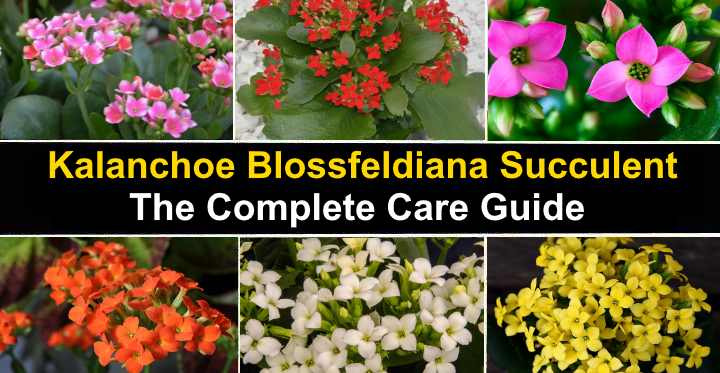
The Kalanchoe blossfeldiana is a flowering succulent plant that is easy to care for indoors. Kalanchoes are perennial plants that flower year after year. The flowering kalanchoe produces blooms that are pink, red, white, yellow and orange. Other names for this succulent houseplant are flaming Katy, florist kalanchoe, Madagascar widow’s-thrill, and Christmas kalanchoe.
How to care for kalanchoe: The Kalanchoe blossfeldiana is a flowering succulent that thrives in bright indirect light, well-draining cactus potting mix, and low humidity. Water the kalanchoe when the soil partly dries. The temperature range for a kalanchoe plant is 60°F to 85°F (15°C – 30°C). Fertilize monthly during the growing season.
Kalanchoe blossfeldiana is a species native to Madagascar, where they grow in subtropical climates. The bushy evergreen perennial succulent grows outdoor in partial shade. Kalanchoe plants will grow outside as long as they’re protected from frost and too much direct sunlight.
You can buy kalanchoe plants in garden stores, flower shops, nurseries, and grocery stores if you live in temperate climates.
Kalanchoe is a popular houseplant with round bushy growth, leathery dark-green leaves, and dainty long-lasting flowers. Growing in pots, the kalanchoe grows up to 18” (45 cm) tall with a spread of 20” (50 cm). However, some species of kalanchoe can be somewhat smaller—about 12” (30 cm) high with a spread of 4” (10 cm).
In this article, you will learn how to care for the Kalanchoe blossfeldiana succulent. You’ll also find how to resolve many issues connected with growing kalanchoes at home.
Kalanchoe Flowers

Kalanchoe flowers come in a wide array of colors and include single flower (pink and red flowers in the picture) and double blooms (the yellow kalanchoe blossfeldiana ‘Calandiva’ cultivar)
The pink, red, white, yellow and orange flowers of kalanchoes are the most attractive features. The pretty flowers each have four petals. These flowers grow in clusters to create colorful flowerheads when the bushy kalanchoe blooms.
Kalanchoes naturally produce masses of small showy flowers in early spring. They need a period of six weeks of darkness to produce their flower buds. One of the beauties about this species of flowering succulent is that kalanchoe flowers last a long time—sometimes up to six months.
Kalanchoe flowers come back year after year if you snip off the flowers after they begin to fade. Deadheading kalanchoes helps to encourage vigorous growth. Pruning off dead flower stems is the best way to ensure that your flowering succulent blooms regularly throughout the year—every year.
Some species of Kalanchoe blossfeldiana have showy flowers like a rose. These double-petaled varieties of plants are the calandiva kalanchoe plant. You can distinguish between Kalanchoe and calandiva by their flowers. Kalanchoe has single-petaled flowers but calandiva, has flowers with double petals.
How do I keep my kalanchoe blooming?
To help your kalanchoe produce masses of colorful flowers, the plant needs bright light. As soon as you notice flower buds starting to appear, move the kalanchoe to a sunny location. As long as the succulent is kept out of direct sunlight, the kalanchoe flowers should bloom for a long time.
To trick a kalanchoe into blooming, you should reduce watering and simulate winter lighting conditions. Put the plant in a dark place for 14 hours a day and hold off watering. Do this for six weeks to help stimulate the creation of flower buds. As soon the flower buds appear, move the kalanchoe back to a bright place so it can flower.
Under ideal conditions, kalanchoes flower for up to six months at a time.
Why is my kalanchoe not flowering?
Too much light is usually a reason why a kalanchoe fails to bloom again. Kalanchoe won’t produce flowers if kept in bright sunlight throughout the year. Kalanchoe plants are photoperiodic which means they flower depending on the length of day. Kalanchoe need long periods of darkness daily with minimal watering to produce flower buds.
When the kalanchoe begin to bloom, place them in bright light, and resume regular watering.
How to Care for Kalanchoe
Let’s look at the best ways to care for Kalanchoe blossfeldiana so that you regularly get flowers, and that the leaves and stems stay healthy, free from pests or disease.
Kalanchoe Light Requirements
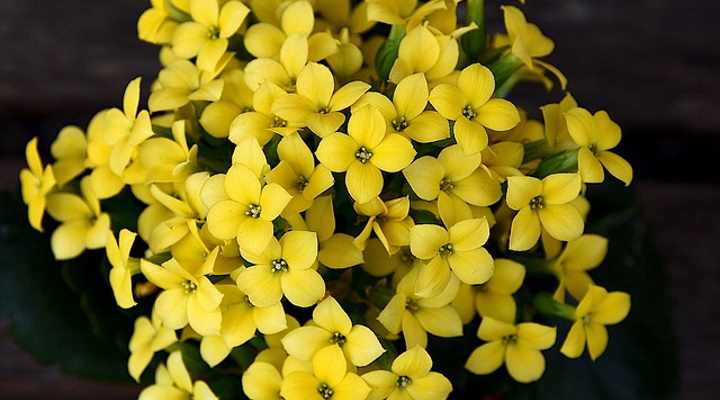
Grow your kalanchoe succulent in a bright location that is protected from direct sunlight
Kalanchoe plants like bright, sunny locations but protected from direct sunlight. Place the kalanchoe pots on an east- or west-facing windowsill. During winter, the flowering succulents get plenty of light at a south-facing window. However, protect the plant from the sun’s direct rays to prevent burning.
Keeping your kalanchoe in bright light for most of the day ensures healthy blooming. When growing in adequate light, you’ll get an array of clusters of red, orange, white, yellow or pink flowers. These blooms should last for many months.
When it comes to getting lighting levels right, a kalanchoe needs periods of darkness to start blooming. As the days get shorter in the fall and you water the plant less, the plant will go into a dormant mode. Ideally, you need to cut the light for 14 hours a day. After about six weeks, flower buds should appear, and you can return the flowering kalanchoe to a bright place with plenty of natural light.
Best Soil for Growing Kalanchoe Indoors
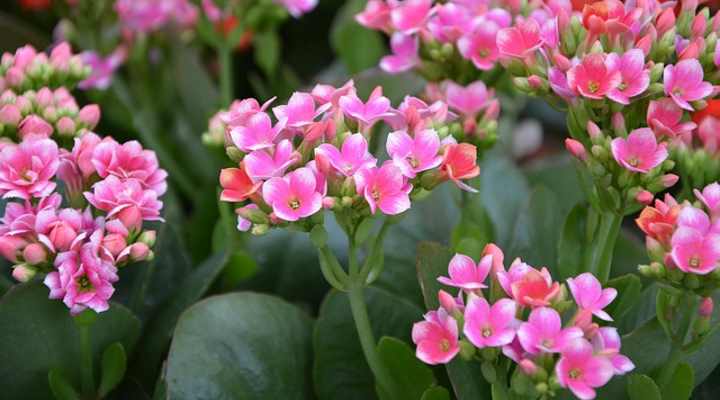
The best soil for growing kalanchoe is a well-draining potting mix for cacti
Grow kalanchoe in a fast-draining potting mix for cacti. To provide the best growing medium, a combination of a cactus mix, potting soil, and perlite is ideal. The light potting mix helps retain some moisture without becoming soggy. Perlite helps water drain fast through the soil.
Other soil amendments to improve drainage for kalanchoes include bark chips, coarse horticultural sand, or charcoal pieces.
The ideal potting medium is necessary to prevent a kalanchoe plant from dying. Succulent roots that sit in overly-damp soil become rotten and diseased. Root rot will cause your kalanchoe to have limp growth, soggy stems, and eventual death.
Of course, proper care for indoor kalanchoe plants require the right type of soil and correct watering techniques.
How to Water a Kalanchoe
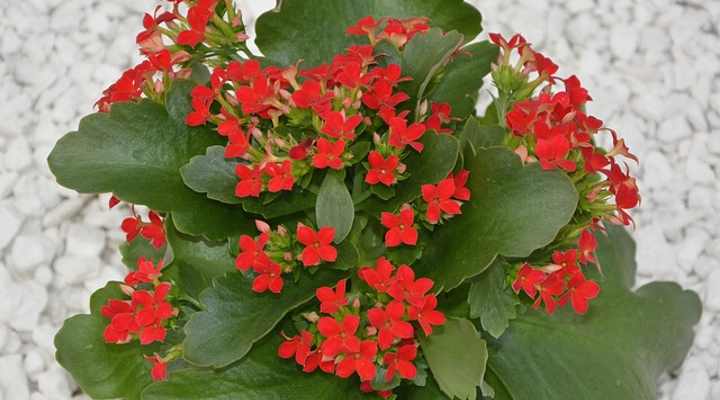
Water your kalanchoe succulent only when the soil dries out
Water a kalanchoe plant as often as the soil dries out. In hot weather, you may have to water a kalanchoe as frequently as every week. In the fall and winter, only water your kalanchoe succulent every six to eight weeks. However, let soil dryness be your guide when to water your kalanchoe.
To water a kalanchoe plant, thoroughly drench the soil until water drips out the pot’s drainage holes. Deep houseplant watering allows the roots to get thoroughly hydrated. But to irrigate the succulent correctly, you must wait until at least 50 percent of the soil is dry before watering.
Because kalanchoe plants are easy-to-care-for succulent houseplants, they can withstand some drought. Remember that watering less often is better than watering too frequently.
How can you tell if your kalanchoe needs watering? Poke your finger 2” (5 cm) into the soil. If it’s bone dry, it’s time to water your evergreen perennial kalanchoe houseplant. If there’s still moisture, hold off watering for a week or so.
Kalanchoe Temperature Requirements
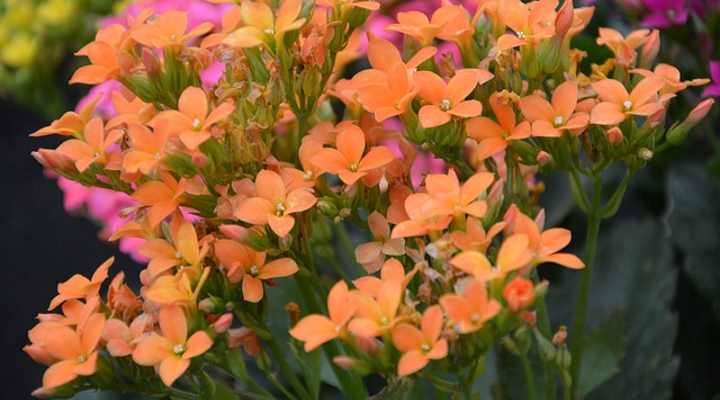
To properly care for your kalanchoe plant, keep it in an average room temperature
Regular household temperature is perfect for growing healthy kalanchoe plants. Temperatures between 60°F and 85°F (15°C – 30°C) will help ensure healthy growth. Keep the kalanchoe plant pot in warm, bright locations and protected from cold drafts.
The minimum temperature for kalanchoe plants is 40°F (4°C). The kalanchoe can die if it’s left for more than a few hours in cold temperatures.
You can grow kalanchoe plants outdoors if you live in USDA zones 10 and 11. If you live in temperate climates, you can take potted kalanchoe plants outside in the summer. Grow the heat-loving succulents in dappled sunlight or partial shade. To prevent plant damage, bring it back indoors if the temperature drops to 50°F (10°C).
Kalanchoe Humidity
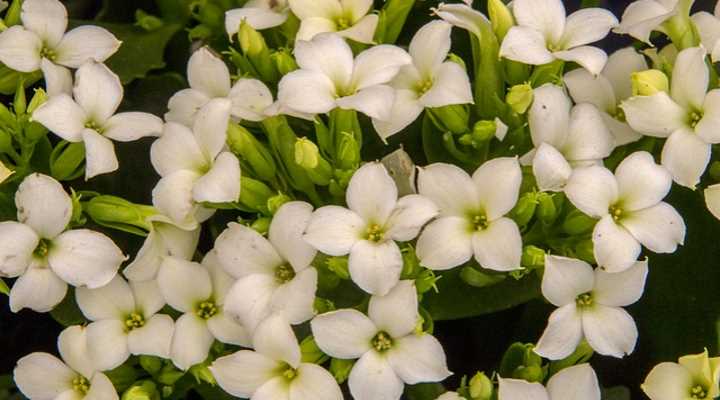
Kalanchoe plants grow well in low humidity conditions with good air circulation
Kalanchoe plants need to grow in low humidity. Generally, the dry air conditions in a house are ideal for keeping these flowering succulents growing healthy. Keeping the plant in a dry room with good air circulation and near a windowsill ensures that the flowers bloom for a long time.
You never need to mist a kalanchoe plant’s leaves. High humidity levels can cause plant diseases such as powdery mildew or leaf spot. If you notice signs of white mold on plants or discolored leaves, move the plant to a drier environment. Also, hold off watering until the soil dries out.
Fertilizing a Kalanchoe
Kalanchoe plants have few fertilizing needs. At the most, you only need to apply a diluted, balanced houseplant fertilizer once a month during the growing season. However, you may only need to fertilize a kalanchoe twice a year—once in spring and once in summer.
Kalanchoes are slow-growing perennial succulents and self-sufficient plants. Therefore, there is no need to feed the plant regularly throughout the year.
Here are a few tips on how to fertilize kalanchoe:
- Use a balanced organic 20-20-20 fertilizer for your kalanchoe and dilute to the manufacturer’s instructions.
- Flush the soil every so often to prevent a buildup of mineral salts and avoid root burn.
- Never apply fertilizers to a kalanchoe plant during the fall or winter.
Learn about the best houseplant fertilizers and how to use them.
Pinching Kalanchoe Plants to Encourage Healthy Growth
Pinching off dead flower stalks helps kalanchoe plants grow fuller and ensure that the flowers come back year after year. The time to pinch off dead or dying blooms is in spring after the plant has finished flowering. Snip off kalanchoe flower stalks with sterile shears near the base of the stems.
Cut back any leggy growth that you notice on your kalanchoe. Pruning long straggly stems helps to promote healthy plant growth. Pinching off leggy kalanchoe stems also keeps the plant in its round, bushy shape and encourages regular blooming. You should also remove discolored or dead leaves.
Repotting a Kalanchoe
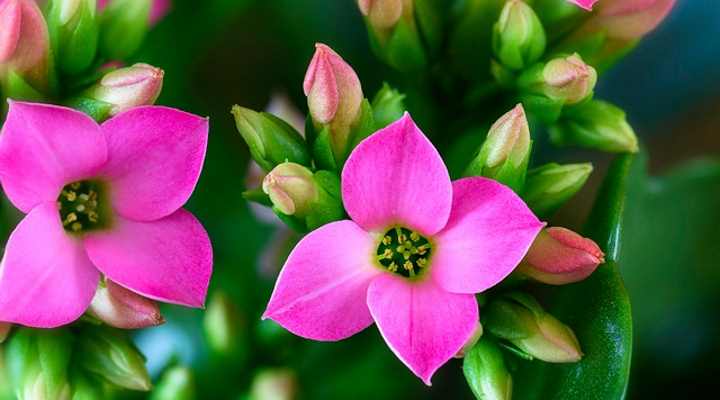
Kalanchoe succulents don’t need to be repotted very often
Slow-growing kalanchoes don’t need repotting very often. Transfer a kalanchoe to a larger pot in the spring if it’s outgrown its current pot. Repotting a kalanchoe encourages healthy growth as it gives the roots more room to grow. This helps ensure an abundance of pink, red, orange, yellow or white flowers.
To repot a kalanchoe, gently ease the root ball from the container. Then, shake off excess dirt and rinse the roots with clean water. Check for signs of root decay roots—brown, mushy roots—and prune as necessary. Half-fill a new, larger pot with a cactus potting mix and put the kalanchoe in the new container. Fill the remaining space with the rest of the potting medium.
How to you know if your kalanchoe needs repotting? Here are a few tell-tale signs:
- Roots are poking out the pot’s drainage holes.
- Water doesn’t drain quickly from the pot.
- Water pools on the surface of the soil.
The best type of pot for a kalanchoe succulent is a terracotta pot.
Propagating Kalanchoe Succulents
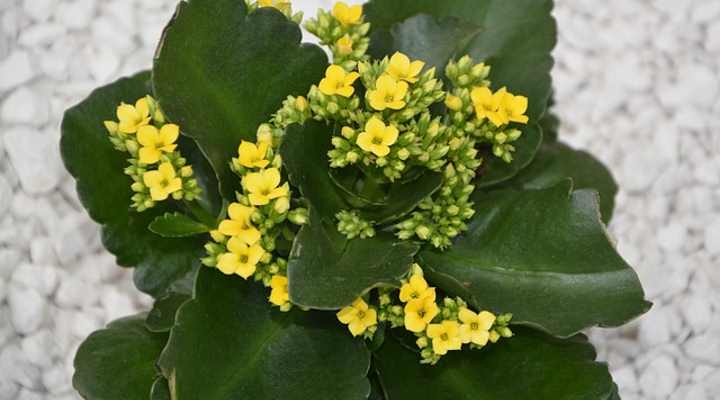
You can propagate your kalanchoe plant by stem cuttings or root division
Propagate kalanchoe plants using stem cuttings. To propagate kalanchoe, cut a length of healthy stems that has a few leaves on it. Remove the leaves from the bottom 2” (5 cm) of the stem. Let the cutting dry for three to five days on a paper towel. Transfer to a pot that has appropriate kalanchoe soil.
Root division is another way to grow a new kalanchoe succulent. To propagate a kalanchoe by root division, remove the plant from its pot. Separate the root into two or three parts, making sure there is at least one healthy stem with a few leaves in each section. Transfer each part of the root to a new pot.
To make sure a newly-propagated kalanchoe grows well, you should increase humidity. Mist the soil to help keep the rooted stem moist. Put a plastic bag over the plant pot to increase humidity so that the kalanchoe grows fast. Place the rooted cutting in bright, indirect sunlight and water weekly.
After three weeks, the cutting should be fully rooted. You can remove the plastic bag and care for the kalanchoe as usual.
Pests Affecting Kalanchoe Growth
Kalanchoe—similar to other succulents and cacti—are relatively resistant to pests. Use a neem oil solution or insecticidal soap to get rid of houseplant pests. Some pests that can affect kalanchoe growth are aphids, mealybugs, or spider mites. Learn how to spot the first signs of a plant infestation.
Diseases Affecting Kalanchoe Growth
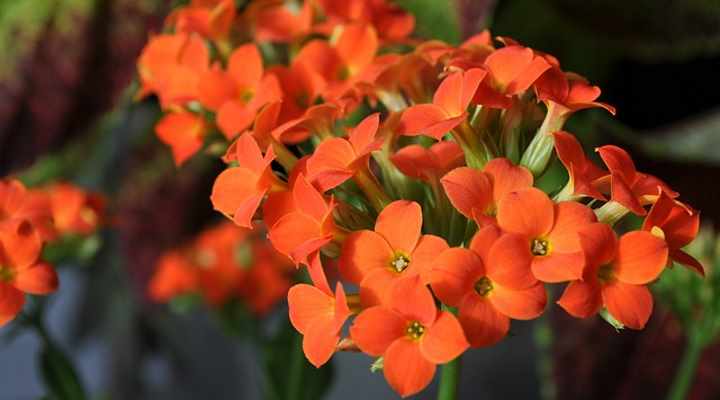
Over-watering and high humidity can cause kalanchoe houseplant to be susceptible to diseases
Root rot can cause a kalanchoe plant to die. To avoid root rot affecting your succulent plants, ensure you water them appropriately. Ensure that soil dries out between watering and that it’s never moist when you hydrate the plant.
High humidity can cause powdery mildew on kalanchoe leaves. To prevent powdery mildew, try to avoid getting water on the leaves. Also, ensure there is plenty of air circulation so that moisture doesn’t buildup in the foliage. The white fuzzy growth of powdery mildew can look like spots on the leaves or turn the leaves brown.
Are Kalanchoe Plants Poisonous?
Kalanchoe plants are toxic to dogs, cats, and other household pets. According to the ASPCA, dogs or cats that ingest kalanchoe leaves can have diarrhea, vomiting, or abnormal heart rhythm.
FAQs about Growing Kalanchoe Plants
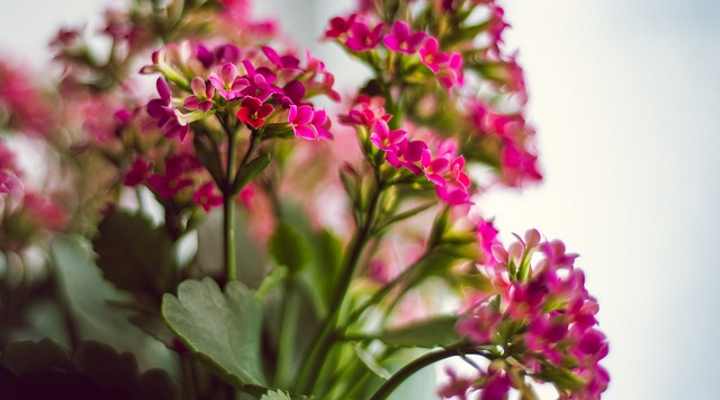
Kalanchoe succulents are relatively low maintenance and easy to care for houseplants
Although the flowering succulent species Kalanchoe blossfeldiana is a low-maintenance houseplant, some issues can affect its growth.
What are brown spots on kalanchoe leaves?
Brown spots on kalanchoe leaves could be due to a buildup of mineral salts in the potting soil. To help restore your plant to good health, flush the soil by pouring water through it for a couple of minutes. Remember that a kalanchoe only needs occasional fertilizing—if at all.
Why is my kalanchoe dying?
Over-watering is usually the reason for weak, limp kalanchoe growth. To help revive a dying kalanchoe, hold off watering until the soil dries out. If the potting mix is especially soggy, try repotting the succulent with a sterile potting medium that is slightly moist.
Why is my kalanchoe wilting?
Watering issues are usually to blame for a kalanchoe that is wilting. Too little water or too much water can affect the roots and result in weak growth. Because kalanchoes are among the top drought-resistant houseplants, over-watering—not under-watering—is usually the cause of wilting growth.
How to Care for Succulents: Growing Succulents and Keeping Them Alive
Related articles:
